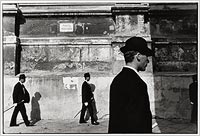|

Working
for a period of years on a daily newspaper is a great education,
especially in a place like Palermo, where at any moment you
might see someone you knew -a policeman, a journalist, a magistrate-
killed by an assassin. And so we told ourselves that we could
no longer go on being passive witnesses to these massacres:
we had in our hands a tool that could be used to inform people
and to combat the phenomenon by helping to forge a new awareness.
At that time, the word "mafia" could not be pronounced
in a public place. Everyone was terrorised. We began to organise
exhibitions of photographs to denounce the Mafia and expose
its true face. In a newspaper, this sort of thing remains
superficial, ephemeral, sporadic; while an exhibition of photographs,
displayed all together in a public place, immediately reveals
the gravity of the situation and the responsibilities that
lie behind it. I remember the first exhibition we put together:
it was shown in schools, in villages, in town squares. People
were afraid to come up and take a close look at the pictures...
I also worked with the foreign press, the Americans, the British,
the French, the Japanese... I was their correspondent in Sicily.
In 1985 Letizia Battaglia submitted her portfolio for the
Eugene Smith Prize, and won it - that was an important international
recognition, and it encouraged us to continue.
In 1988 I was enrolled by the Magnum Agency.
This was a tremendous experience, for I had to leave Sicily
and work as a photographer for major magazines, dealing with
problems that had never come my way before. But with Magnum
there were problems of comprehension, and I didn't want to
lose my passion for photography. So after three years, I left.
Working with Magnum gave me my first opportunity to travel
to the Eastern Bloc. This was before the Wall came down, and
it was still possible then to produce pictures in a neo-realistic
style, like the '50s in the West. And I was fascinated to
see that on the other side of Europe people lived a different
everyday reality, with different day-to-day problems. I began
to explore Poland, Lithuania, Estonia, Romania, Czechoslovakia,
Bulgaria, Georgia... What mainly interested me in these countries
was their cultural, artistic, political and economic life.
In 1990 I spent four months working in Silesia (southwest
Poland), the most polluted region in Europe, on the effects
of pollution on health. I felt compelled to dig deeply into
all the associated social problems. This project also permitted
me to deliver the results of my investigation to the University
of Katowice in the form of an exhibition, which continues
to manage it to this day. This was accompanied by a written
report, which was approved by the University before the exhibition
was opened.
After the collapse of the communist regimes, the East became
a favourite playground for photo reporters. Events had left
me behind, and the newspapers and magazines were saturated
with facile and stereotyped pictures.
In 1991 I decided to go and live in Paris. My work denouncing
the Mafia was no longer as necessary as before: by this time
a collective awareness had developed and the subject was well
covered by the media. My life and work in Palermo was no longer
satisfying, and had become a pointless risk. I was a photographer
before I became the photographer of the Mafia, and this label
was hobbling my creative spirit. And so I abandoned a professionally
privileged position (for I had become internationally famous
for my work on the Mafia) to plunge into a marketplace that
was seriously affected by the economic crisis, and where I
had no certainty that I could make a place for myself.
|







